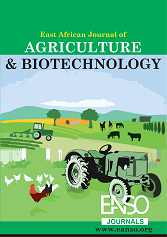Usage of Agroecological Climate-Smart Agriculture Practices among Sorghum and Maize Smallholder Farmers in Semi-Arid Areas in Tanzania
Résumé
Climate change variability and its impact on agricultural production in sub-Saharan Africa pose a significant challenge to food security. In Tanzania's semi-arid regions, there is growing concern regarding the use of agroecological Climate-Smart Agriculture (CSA) practices by smallholder farmers that adhere to agroecological principles. This study aimed to investigate the use of agroecological CSA practices among smallholder farmers in Tanzania's semi-arid regions, specifically in Dodoma and Tabora regions. In addition, this study sought to identify the key factors influencing the use of these practices to enhance food security, income, and climate resilience. Data were collected from 299 households in Dodoma and Tabora using various methods including questionnaire surveys, focus group discussions, and key informant interviews. Binary logistic regression was used to analyse factors influencing the usage of agroecological climate-smart agriculture practices. The findings revealed that most households in the study area use agroecological CSA practices. These practices include cereal-legume intercropping, mixed cropping, crop residue retention, crop rotation, and improved seed variety. Water harvesting, terraces, and cover crops were not used by many households. Several factors positively influenced the use of agroecological CSA. They include assistance from non-governmental organizations (NGOs), training in CSA practices, drought perception, access to credit, distance to market, membership in an organisation, education level of the household head, and total household income. To promote the use of agroecological CSA practices, both governments and NGOs should prioritise training programs. Moreover, providing frequent extension services and facilitating easier access to credit for farmers can further support the widespread use of these practices. In doing so, local communities can adapt better to the challenges of climate change, ensuring improved food security and climate resilience in the region
##plugins.generic.usageStats.downloads##
Références
Abdallah, A.-H., Abdul-Rahaman, A., & Issahaku, G. (2021). Sustainable agricultural practices, farm income and food security among rural households in Africa. Environment, Development and Sustainability, 23(12), 17668–17701. https://doi.org/10.1007/s10668-021-01407-y
Abera, A., Yirgu, T., & Uncha, A. (2021). Determinants of rural livelihood diversification strategies among Chewaka resettlers’ communities of southwestern Ethiopia. Agriculture & Food Security, 10(1), 30. https://doi.org/10.1186/s40066-021-00305-w
Agula, C., Akudugu, M. A., Dittoh, S., & Mabe, F. N. (2018). Promoting sustainable agriculture in Africa through ecosystem‑based farm management practices: Evidence from Ghana. Agricultural and Food Science. https://doi.org/10.1186/s40066-018-0157-5
Akinyi, D. P., Ng’ang’a, S. K., Ngigi, M., Mathenge, M., & Girvetz, E. (2022). Cost-benefit analysis of prioritized climate-smart agricultural practices among smallholder farmers: Evidence from selected value chains across sub-Saharan Africa. Heliyon, 8(4). https://doi.org/10.1016/j.heliyon.2022.e09228
Akter, R., Hasan, M. K., Kabir, K. H., Darr, D., & Roshni, N. A. (2022). Agroforestry systems and their impact on livelihood improvement of tribal farmers in a tropical moist deciduous forest in Bangladesh. Trees, Forests and People, 9, 100315.
Alomia-Hinojosa, V., Speelman, E. N., Thapa, A., Wei, H.-E., McDonald, A. J., Tittonell, P., & Groot, J. C. (2018). Exploring farmer perceptions of agricultural innovations for maize-legume intensification in the mid-hills region of Nepal. International Journal of Agricultural Sustainability, 16(1), 74–93.
Altieri, M. A., & Nicholls, C. I. (2017). The adaptation and mitigation potential of traditional agriculture in a changing climate. Climatic Change, 140(1), 33–45. https://doi.org/10.1007/s10584-013-0909-y
Amadu, F. O., McNamara, P. E., & Miller, D. C. (2020). Yield effects of climate-smart agriculture aid investment in southern Malawi. Food Policy, 92. https://doi.org/10.1016/j.foodpol.2020.101869
Asante, B. O., Villano, R. A., Patrick, I. W., & Battese, G. E. (2018). Determinants of farm diversification in integrated crop–livestock farming systems in Ghana. Renewable Agriculture and Food Systems, 33(2), 131–149. https://doi.org/10.1017/S1742170516000545
Asmare, F., Teklewold, H., & Mekonnen, A. (2019). The effect of climate change adaptation strategy on farm households welfare in the Nile basin of Ethiopia: Is there synergy or trade-offs? International Journal of Climate Change Strategies and Management.
Bang, S., Bishnoi, R., Chauhan, A. S., Dixit, A. K., & Chawla, I. (2019). Fuzzy logic based crop yield prediction using temperature and rainfall parameters predicted through ARMA, SARIMA, and ARMAX models. 2019 Twelfth International Conference on Contemporary Computing (IC3), 1–6.
Bezner Kerr, R., Madsen, S., Stüber, M., Liebert, J., Enloe, S., Borghino, N., Parros, P., Mutyambai, D. M., Prudhon, M., & Wezel, A. (2021). Can agroecology improve food security and nutrition? A review. Global Food Security, 29. https://doi.org/10.1016/j.gfs.2021.100540
Bongole, A. J., Hella, J., Kikuu, C., Resource, N., & Kikuu, C. (2020). Usage of climate smart agriculture practices: An analysis of farm households’ decisions in southern highlands of tanzania 1. Ajol. Info, 19(2), 238–255.
Bowles, T. M., Mooshammer, M., Socolar, Y., Calderón, F., Cavigelli, M. A., Culman, S. W., Deen, W., Drury, C. F., Garcia y Garcia, A., Gaudin, A. C. M., Harkcom, W. S., Lehman, R. M., Osborne, S. L., Robertson, G. P., Salerno, J., Schmer, M. R., Strock, J., & Grandy, A. S. (2020). Long-Term Evidence Shows that Crop-Rotation Diversification Increases Agricultural Resilience to Adverse Growing Conditions in North America. One Earth, 2(3), 284–293. https://doi.org/10.1016/j.oneear.2020.02.007
Chauhan, B. S., & Abugho, S. B. (2013). Effect of crop residue on seedling emergence and growth of selected weed species in a sprinkler-irrigated zero-till dry-seeded rice system. Weed Science, 61(3), 403–409.
Chiputwa, B., Wainaina, P., Nakelse, T., Makui, P., & ... (2020). Transforming climate science into usable services: The effectiveness of co-production in promoting uptake of climate information by smallholder farmers in …. In Climate Services. Elsevier. https://www.sciencedirect.com/science/article/pii/S2405880720300558
Debaeke, P., Casadebaig, P., Flenet, F., & Langlade, N. (2017). Sunflower crop and climate change: Vulnerability, adaptation, and mitigation potential from case-studies in Europe. OCL Oilseeds and Fats Crops and Lipids, 24(1), 15-p.
Deng, C., Zhang, G., Liu, Y., Nie, X., Li, Z., Liu, J., & Zhu, D. (2021). Advantages and disadvantages of terracing: A comprehensive review. International Soil and Water Conservation Research, 9(3), 344–359. https://doi.org/10.1016/j.iswcr.2021.03.002
Fahad, S., Chavan, S. B., Chichaghare, A. R., Uthappa, A. R., Kumar, M., Kakade, V., Pradhan, A., Jinger, D., Rawale, G., Yadav, D. K., & others. (2022). Agroforestry systems for soil health improvement and maintenance. Sustainability, 14(22), 14877.
FAO. (2018). The 10 elements of agroecology: Guiding the transition to sustainable food and agricultural systems. FAO Rome, Italy.
Fentie, A., & Beyene, A. D. (2018). Climate-smart agricultural practices and welfare of rural smallholders in ethiopia: Does planting method matter? EfD DP. Environment for Development (pp. EfD DP 18-08). Discussion Paper Series. Retrieved April.
Gebre, G. G., Isoda, H., Rahut, D. B., Amekawa, Y., & Nomura, H. (2021). Gender differences in agricultural productivity: Evidence from maize farm households in southern Ethiopia. GeoJournal, 86(2), 843–864.
Gebregergis, Z. (2016). Cropping systems of east africa: A review. Developing Country Studies, 6, 2225–0565.
Harvey, C., Chacón, M., Donatti, C., Garen, E., & ... (2014). Climate‐smart landscapes: Opportunities and challenges for integrating adaptation and mitigation in tropical agriculture. Conservation …. https://doi.org/10.1111/conl.12066
Iijima, M., Awala, S. K., Watanabe, Y., Kawato, Y., Fujioka, Y., Yamane, K., & Wada, K. C. (2016). Mixed cropping has the potential to enhance flood tolerance of drought-adapted grain crops. Journal of Plant Physiology, 192, 21–25. https://doi.org/10.1016/j.jplph.2016.01.004
Jensen, E. S., Carlsson, G., & Hauggaard-Nielsen, H. (2020). Intercropping of grain legumes and cereals improves the use of soil N resources and reduces the requirement for synthetic fertilizer N: A global-scale analysis. Agronomy for Sustainable Development, 40(1), 1–9.
Kachaka, E. Y., Poirier, V., Munson, A. D., & Khasa, D. P. (2023). Acacia auriculiformis agroforestry fallows of different ages improve soil physico-chemical properties and carbon stocks on the Batéké plateau, Democratic Republic of Congo. Geoderma Regional, e00691.
Kassie, M., Teklewolde, H., Erenstein, O., Jaleta, M., Marenya, P., & Mekurai, M. (2015). Technology diversification: Assessing impacts on crop income and agrochemical uses in Malawi. 1008-2016–80134, 50.
Kazal, M. M. H., Rahman, M. S., & Rayhan, S. J. (2020). Determinants and impact of the adoption of improved management practices: Case of freshwater prawn farming in Bangladesh. Aquaculture Reports, 18, 100448.
Kopittke, P. M., Menzies, N. W., Wang, P., McKenna, B. A., & Lombi, E. (2019). Soil and the intensification of agriculture for global food security. Environment International, 132, 105078.
Kurgat, B. K., Kurgat, B. K., Kurgat, B. K., Kurgat, B. K., Lamanna, C., Kimaro, A. A., Namoi, N., Manda, L., & Rosenstock, T. S. (2020). Adoption of climate-smart agriculture technologies in tanzania. Frontiers in Sustainable Food Systems. https://doi.org/10.3389/fsufs.2020.00055
Kurgat, B. K., Lamanna, C., Kimaro, A., Namoi, N., Manda, L., & Rosenstock, T. S. (2020). Adoption of climate-smart agriculture technologies in tanzania. Frontiers in Sustainable Food Systems, 4(5). https://doi.org/10.3389/fsufs.2020.00055
Liang, Z., Zhang, L., Li, W., Zhang, J., & Frewer, L. J. (2021). Adoption of combinations of adaptive and mitigatory climate-smart agricultural practices and its impacts on rice yield and income: Empirical evidence from Hubei, China. Climate Risk Management, 32. https://doi.org/10.1016/j.crm.2021.100314
Loboguerrero, A. M., Campbell, B. M., Cooper, P. J., Hansen, J. W., Rosenstock, T., & Wollenberg, E. (2019). Food and earth systems: Priorities for climate change adaptation and mitigation for agriculture and food systems. Sustainability, 11(5), 1372.
Luu, T. D. (2020). Factors influencing farmers’ adoption of climate-smart agriculture in rice production in vietnam’s mekong delta. Asian Journal of Agriculture and Development, 17(1), 109–124. https://doi.org/10.37801/ajad2020.17.1.7
Martey, E., Etwire, P. M., & Mockshell, J. (2021). Climate-smart cowpea adoption and welfare effects of comprehensive agricultural training programs. Technology in Society, 64, 101468. https://doi.org/10.1016/j.techsoc.2020.101468
Matata, P., Bushesha, M., & Msindai, J. (2018). Adaptation to Climate Variability and Change in Semi-Arid Areas of Tanzania: A Case of Igunga and Kishapu Districts in Tanzania. 3(2), 55–74.
Mbow, C., Rosenzweig, C., Barioni, L., Benton, T., Herrero, M., Krishnapillai, M., Liwenga, E., Pradhan, P., Rivera-Ferre, M., Sapkota, T., & others. (2019). Food security. In climate change and land: An IPCC special report on climate change, desertification, land degradation, sustainable land management, food security, and greenhouse gas fluxes in terrestrial ecosystems. Intergovernmental Panel on Climate Change.
Megersa, B., Markemann, A., Angassa, A., Ogutu, J. O., Piepho, H.-P., & Valle Zárate, A. (2014). Livestock diversification: An adaptive strategy to climate and rangeland ecosystem changes in southern Ethiopia. Human Ecology, 42(4), 509–520.
Mgoba, S. A., & Kabote, S. J. (2020). Effectiveness of participatory monitoring and evaluation on achievement of community-based water projects in Tanzania. Applied Water Science, 10(8), 200. https://doi.org/10.1007/s13201-020-01273-5
Midingoyi, S. kifouly G., Kassie, M., Muriithi, B., Diiro, G., & Ekesi, S. (2019). Do farmers and the environment benefit from adopting integrated pest management practices? Evidence from kenya. Journal of Agricultural Economics, 70(2), 452–470.
Mishra, P. K., Rai, A., Abdelrahman, K., Rai, S. C., & Tiwari, A. (2022). Land degradation, overland flow, soil erosion, and nutrient loss in the Eastern Himalayas, India. Land, 11(2), 179.
Mkonda, M. Y., & He, X. (2018a). Climate variability and crop yields synergies in Tanzania’s semiarid agroecological zone. Ecosystem Health and Sustainability, 4(3), 59–72. https://doi.org/10.1080/20964129.2018.1459868
Mkonda, M. Y., He, X., & Festin, E. S. (2018b). Comparing smallholder farmers’ perception of climate change with meteorological data: Experience from seven agroecological zones of Tanzania. Weather, Climate, and Society, 10(3), 435–452.
Mogaka, B. O., Bett, H. K., & Ng’ang’a, S. K. (2021). Socioeconomic factors influencing the choice of climate-smart soil practices among farmers in western Kenya. Journal of Agriculture and Food Research, 5. https://doi.org/10.1016/j.jafr.2021.100168
Monti, M., Pellicanò, A., Pristeri, A., Badagliacca, G., Preiti, G., & Gelsomino, A. (2019). Cereal/grain legume intercropping in rotation with durum wheat in crop/livestock production systems for Mediterranean farming system. Field Crops Research, 240, 23–33. https://doi.org/10.1016/j.fcr.2019.05.019
Moradi, R., Koocheki, A., Nassiri Mahallati, M., & Mansoori, H. (2013). Adaptation strategies for maize cultivation under climate change in Iran: Irrigation and planting date management. Mitigation and Adaptation Strategies for Global Change, 18(2), 265–284. https://doi.org/10.1007/s11027-012-9410-6
Mulwa, C., Marenya, P., Rahut, D. B., & Kassie, M. (2017). Response to climate risks among smallholder farmers in Malawi: A multivariate probit assessment of the role of information, household demographics, and farm characteristics. Climate Risk Management, 16, 208–221.
Murphy, R. P., Montes-Molina, J. A., Govaerts, B., Six, J., van Kessel, C., & Fonte, S. J. (2016). Crop residue retention enhances soil properties and nitrogen cycling in smallholder maize systems of Chiapas, Mexico. Applied Soil Ecology, 103, 110–116. https://doi.org/10.1016/j.apsoil.2016.03.014
Musumba, M., Palm, C. A., Komarek, A. M., Mutuo, P. K., & Kaya, B. (2022). Household livelihood diversification in rural Africa. Agricultural Economics, 53(2), 246–256.
Mwadzingeni, L., Mugandani, R., & Mafongoya, P. L. (2023). Perception of climate change and coping strategies among smallholder irrigators in Zimbabwe. Frontiers in Sustainable Food Systems, 7, 1027846.
Mylona, P., Sakellariou, M., Giannakopoulos, C., Psiloglou, B., & Kitsara, G. (2020). Terrace landscapes as green infrastructures for a climate-smart agriculture to mitigate climate change impacts. In Vlontzos G. & Koutsou S. (Eds.), CEUR Workshop Proc. (Vol. 2761, pp. 236–243). CEUR-WS; Scopus. https://www.scopus.com/inward/record.uri?eid=2-s2.0-85097544470&partnerID=40&md5=65058756f48d399acf1c69ab4bf796b4
Naazie, G. K., Dakyaga, F., & Derbile, E. K. (2023). Agro-ecological intensification for climate change adaptation: Tales on soil and water management practices of smallholder farmers in rural Ghana. Discover Sustainability, 4(1), 27. https://doi.org/10.1007/s43621-023-00142-w
Nassary, E. K., Baijukya, F., & Ndakidemi, P. A. (2020). Productivity of intercropping with maize and common bean over five cropping seasons on smallholder farms of Tanzania. European Journal of Agronomy, 113, 125964.
Nicholls, C. I., & Altieri, M. A. (2018). Pathways for the amplification of agroecology. Agroecology and Sustainable Food Systems, 42(10), 1170–1193. https://doi.org/10.1080/21683565.2018.1499578
Nyantakyi-Frimpong, H. (2017). Agricultural diversification and dietary diversity: A feminist political ecology of the everyday experiences of landless and smallholder households in northern Ghana. Geoforum; Journal of Physical, Human, and Regional Geosciences, 86, 63–75.
Nyenza, O. M., Nzunda, E. F., & Katani, J. Z. (2013). Socio-ecological resilience of people evicted for establishment of Uluguru Nature Reserve in Morogoro Region, Tanzania. Forests, Trees and Livelihoods, 22(3), 190–203.https://doi.org/10.1080/14728028.2013.810405
Ogada, M. J., Radeny, M., Recha, J., & Solomon, D. (2020). Adoption of climate-smart agricultural technologies in lushoto climate-smart villages in north-eastern tanzania. Working paper No.325.
Onyeneke, R. U., Amadi, M. U., Njoku, C. L., & Osuji, E. E. (2021). Climate change perception and uptake of climate-smart agriculture in rice production in Ebonyi state, Nigeria. Atmosphere, 12, 1–21. https://doi.org/10.3390/atmos12111503
Ortiz-Bobea, A., Ault, T. R., Carrillo, C. M., Chambers, R. G., & Lobell, D. B. (2021). Anthropogenic climate change has slowed global agricultural productivity growth. Nature Climate Change, 11(4), 306–312.
Osewe, M., Miyinzi Mwungu, C., & Liu, A. (2020). Does minimum tillage improve smallholder farmers’ welfare? Evidence from Southern Tanzania. Land, 9(12), 513.
Ouda, S., Zohry, A., & Noreldin, T. (2018). Crop rotation maintains soil sustainability. In Crop rotation (pp. 55–76). Springer.
Raseduzzaman, M., & Jensen, E. S. (2017). Does intercropping enhance yield stability in arable crop production? A meta-analysis. European Journal of Agronomy, 91, 25–33.
Rehima, M., Belay, K., Dawit, A., & Rashid, S. (2013). Factors affecting farmers’ crops diversification: Evidence from SNNPR, Ethiopia. International Journal of Agricultural Sciences, 3(6), 558–565.
Rosa, L., & Gabrielli, P. (2023). Achieving net-zero emissions in agriculture: A review. Environmental Research Letters, 18(6), 063002.
Rosa-Schleich, J., Loos, J., Mußhoff, O., & Tscharntke, T. (2019). Ecological-economic trade-offs of diversified farming systems–a review. Ecological Economics, 160, 251–263.
Rowhani, P., Lobell, D. B., Linderman, M., & Ramankutty, N. (2011). Climate variability and crop production in Tanzania. Agricultural and Forest Meteorology, 151(4), 449–460.
Rusinamhodzi, L., Thierfelder, C., Berre, D., & ... (2015a). Prospects of climate smart agriculture (CSA) under low-input and rain-fed conditions in southern Africa.[P67]. agritrop.cirad.fr. https://agritrop.cirad.fr/576620
Rusinamhodzi, L., van Wijk, M. T., Corbeels, M., Rufino, M. C., & Giller, K. E. (2015b). Maize crop residue uses and trade-offs on smallholder crop-livestock farms in Zimbabwe: Economic implications of intensification. Agriculture, Ecosystems & Environment, 214, 31–45.
Sabasi, D., Shumway, C. R., & Kompaniyets, L. (2021). Analysis of Credit Access, U.S. Agricultural Productivity, and Residual Returns to Resources. Journal of Agricultural and Applied Economics, 53(3), 389–415. https://doi.org/10.1017/aae.2021.17
Sanou, J., Bationo, B. A., Barry, S., Nabie, L. D., Bayala, J., & Zougmore, R. (2016). Combining soil fertilization, cropping systems and improved varieties to minimize climate risks on farming productivity in northern region of Burkina Faso. Agriculture & Food Security, 5(1), 1–12.
Sarma, A. K., Sarma, P. K., & Chakrovorty, M. (2023). Water harvesting and management for sustainable agriculture and environment. In Sustainable Agriculture and the Environment (pp. 127–144). Elsevier. https://doi.org/10.1016/B978-0-323-90500-8.00015-4
Schaller, M., Barth, E. I., Blies, D., Röhrig, F., & Schümmelfeder, M. (2017). Climate smart agriculture (CSA): Water harvesting.
Serdeczny, O., Adams, S., Baarsch, F., Coumou, D., Robinson, A., Hare, W., Schaeffer, M., Perrette, M., & Reinhardt, J. (2017). Climate change impacts in Sub-Saharan Africa: From physical changes to their social repercussions. Regional Environmental Change, 17(6), 1585–1600. https://doi.org/10.1007/s10113-015-0910-2
Shikuku, K. M., Valdivia, R. O., Paul, B. K., Mwongera, C., Winowiecki, L., Läderach, P., Herrero, M., & Silvestri, S. (2017). Prioritizing climate-smart livestock technologies in rural Tanzania: A minimum data approach. Agricultural Systems, 151, 204–216. https://doi.org/10.1016/j.agsy.2016.06.004
Simtowe, F., & Mausch, K. (2019). Who is quitting? An analysis of the dis-adoption of climate smart sorghum varieties in Tanzania. International Journal of Climate Change Strategies and Management, 11(3), 341–357. https://doi.org/10.1108/IJCCSM-01-2018-0007
Singh, R., & Singh, G. S. (2017). Traditional agriculture: A climate-smart approach for sustainable food production. Energy, Ecology and Environment, 2(5), 296–316. Scopus. https://doi.org/10.1007/s40974-017-0074-7
Stephen, L., Zubeda, M., & Hugo, D. G. (2014). The use of improved maize varieties in Tanzania. African Journal of Agricultural Research, 9(7), 643–657. https://doi.org/10.5897/AJAR11.065
Synnevåg, G., Kabote, S. J., Nombo, C. I., Mamiro, D., & Mattee, A. Z. (2015). Smallholder adaptation to climate change in semi-arid areas of Tanzania: Experiences from Iramba and Meatu districts. In In Sustainable intensification to advance food security and enhance climate resilience in Africa (pp. 467–485). Springer, Cham.
Takwa, T. (2011). Differences between the socio-economic characteristics of male and female household heads and their households in Cameroon.
Teixeira, E. I., de Ruiter, J., Ausseil, A.-G., Daigneault, A., Johnstone, P., Holmes, A., Tait, A., & Ewert, F. (2018). Adapting crop rotations to climate change in regional impact modelling assessments. Science of the Total Environment, 616, 785–795.
Teklewold, H., Gebrehiwot, T., & Bezabih, M. (2019a). Climate smart agricultural practices and gender differentiated nutrition outcome: An empirical evidence from Ethiopia. World Development, 122, 38–53.
Teklewold, H., Mekonnen, A., & Kohlin, G. (2019b). Climate change adaptation: A study of multiple climate-smart practices in the Nile Basin of Ethiopia. Climate and Development, 11(2), 180–192.
Tessema, Y. A., Joerin, J., & Patt, A. (2019). Crop switching as an adaptation strategy to climate change: The case of Semien Shewa Zone of Ethiopia. International Journal of Climate Change Strategies and Management, 11(3), 358–371. https://doi.org/10.1108/IJCCSM-05-2018-0043
Tolessa, T., Senbeta, F., & Kidane, M. (2017). The impact of land use/land cover change on ecosystem services in the central highlands of Ethiopia. Ecosystem Services, 23, 47–54.
Van Noordwijk, M. (2021). Agroforestry-Based Ecosystem Services: Reconciling Values of Humans and Nature in Sustainable Development. Land, 10(7), 699. https://doi.org/10.3390/land10070699
Vinet, L., & Zhedanov, A. (2011). A “missing” family of classical orthogonal polynomials. In Journal of Physics A: Mathematical and Theoretical, 44(8). https://doi.org/10.1088/1751-8113/44/8/085201
Wakweya, K., Tilahun, A., Megersa, A., Tolesa, D., & Kebede, D. (2021). Contribution of maize-common bean intercropping for food and nutrition security in productive safety net programme areas. Innovations for Food and Livelihood Security, 13.
Wassie, A., & Pauline, N. (2018). Evaluating smallholder farmers’ preferences for climate smart agricultural practices in Tehuledere District, northeastern Ethiopia: Evaluating smallholder farmers’ preferences. Singapore Journal of Tropical Geography, 39(2), 300–316. https://doi.org/10.1111/sjtg.12240
Webber, H., Gaiser, T., & Ewert, F. (2014). What role can crop models play in supporting climate change adaptation decisions to enhance food security in Sub-Saharan Africa? Agricultural Systems, 127, 161–177.
Wezel, A. (2017). Agroecological Practices for Sustainable Agriculture: Principles, Applications, and Making the Transition. WORLD SCIENTIFIC (EUROPE). https://doi.org/10.1142/q0088
Wezel, A., Herren, B. G., Kerr, R. B., Barrios, E., Gonçalves, A. L. R., & Sinclair, F. (2020). Agroecological principles and elements and their implications for transitioning to sustainable food systems. A review. Agronomy for Sustainable Development, 40(6), 1–13.
Yamane, T. (1967). Statistics: An introductory analysis, new york: Harper and row. Sole Proprietorship[] b. Partnership[] c. Limited Liability Company [].
Yokamo, S. (2020). Adoption of improved agricultural technologies in developing countries: Literature. Review. International Journal of Food Science and Agriculture, 4(2), 183–190.
Zerihun, M. F. (2021). Agroforestry practices in livelihood improvement in the Eastern Cape Province of South Africa. Sustainability, 13(15), 8477.
Copyright (c) 2023 Amri Swaibu Yusuph, Emmanuel Fred Nzunda, PhD, Sixbert Kajumula Mourice, PhD, Tommy Dalgaard, PhD

Ce travail est disponible sous la licence Creative Commons Attribution 4.0 International .




























